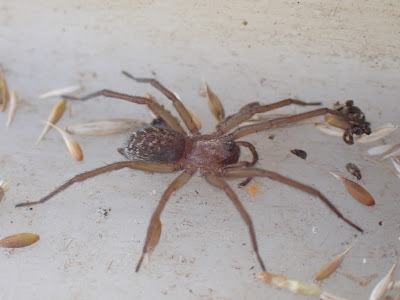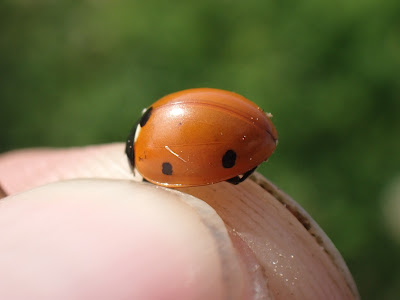I am trying to finish my annual monitoring of the arable margins of the Norfolk Estate this weekend but the weather has been challenging. I shot up to Lee Farm for an hour yesterday afternoon at 3.30 pm after the storms dried out (to make this afternoon a more realistic possibility). This is year six of me monitoring the Peppering side (and year three of the Lee Farm side). This year has so far been exceptional and it is amazing just how any new species are still turning up.

So, here is what happened in just one hour of monitoring two arable margins of two fields yesterday. I recorded 103 field dets in that hour, not in itself exceptional. At about 26 minutes into the survey I looked in the net and saw this!!! Carpocoris purpureiepennis. A recent colonist and a lifer, with very few UK records so far. It was the first to be noted on the new pan-species listing website. I was pretty stoked with this, as there are very few shieldbugs in the UK I have not seen now. I carried on looking through the same sweep net sample, and saw this! The same species but showing how variable they are.
Here they are side by side.
They are pretty big bugs, and strikingly different to anything else. They also look pretty odd underneath.
I walked back and swept a third one, which was very soft and clearly teneral, showing confirmed breeding. Apart from a nymph of this genus recorded in Kent earlier this month, this seems to be the first confirmed breeding of this species in the UK according to Tristan Bantock. Now there are lots of other species in the genus on the Continent, so you really do need to check any Carpocoris carefully.
On the same margin, I turned one big flint and found Eratigena picta, a Nationally Rare house spider with very few records nationally. I had in this field last year and last month.
Other species seen in that hour included a nymph of a Vernal Shieldbug, Dark Green Fritillary, Sitochroa palealis and Cerceris quinquefasciata. It was an eventful hour. I particularly enjoyed this five-spotted ladybird, which is clear an aberrant Seven-spot Ladybird, but shows the importance of correctly writing common names.
But the other day at Peppering was also really exciting. The first margin had a Hornet Robberfly! The first one I have recorded up there in six years.Small Blues have colonised the margins this year with the new seed mix providing plenty of Kidney-vetch.
I found this scarce migrant moth, Loxostege sticicalis. A lifer and with less than 30 Sussex records. Sitochroa palealis and Evergestis extimalis were also new to the site. There were plenty of Clouded Yellows too.Then I nearly tripped over this huge Large Conehead, another recent colonist! This is my first for the site and my first West Sussex record. This is an impressive cricket.
I also heard a Whimbrel flying over and found Knapweed Broomrape.
Last month was exciting too! I stumbled on my first ever Small Marbled there.
As well as a couple of Bordered Straws! Who needs a moth trap when you can just stumble upon moths in fields like this?! It also shows just how much insect migration is happening this year (although I have recorded many more migrant insects here than anywhere else on the Downs this year).
These arable margins are all in place to help the Grey Partridge project up there, which is a fantastic initiative and is really working to help biodiversity across the board. The farmers and keepers are working together with ecologists to produce something really exceptional. I have recorded over 1,000 species on just 16 fields over the years (and have hardly mentioned here the host of native rare species, with over a 100 noted so far). This year, the margins have been incredibly exciting and diverse though. Now hopefully I can get up there this avo and finish the survey for the year...






















What an incredible day! Some amazing insects there.